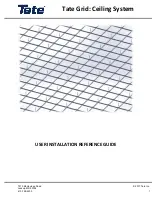
DOC. MIE91093 Rev. 1.34
Page 90 of 145
. VN = Nominal relay phase voltage: it is the nominal voltage
V divided by 1.73. For V = 100 V, then VN = 57,8 V; for V
= 110 V, VN = 62,5 V.
. IN = nominal relay current; usually, 5 A or 1 A.
. Z = fault impedance, on the secondary side.
. KoL = zero-sequence coefficient; it is a number; usually it
ranges between 0.5 and 2.
. If = fault current. The fault current If shall be greater than
the zero voltage starting current IV0, and less than IMAX,
that is computed as a function of the maximum fault
impedance to be simulated ZM, as follows:
Single phase faults: IMAX = VN / (ZM * (1 + KoL))
Phase to phase faults: IMAX = VN / (2 * ZM)
Three phase faults: IMAX = VN / ZM
If the test current is greater than IMAX, the last setting
cannot be found. Usually its value is chosen between 5 and
10 A (for IN = 5 A), or from 1 to 2 A (for IN = 1 A).
. Vf = fault voltage; it is computed as a function of Z and the
other parameters.
. Φ(I-V) = angle of the fault current with respect to the fault
voltage, taken as the reference. Typically, tests are
performed with Φ(I-V) ranging from 0° to 90°.
1.12.3. Relay connection
The first thing is to connect the three T1000 PLUS to the relay
to be tested. The connection depends upon the type of test:
single phase, phase to phase; three phase. The phase angle of
voltages will change as a function of the type of test, and also
as a function of power supply available: single phase or three
phases. The following table summarizes power supply
connections.
FAULT SUPPLY VS1 VN1 VS2 VN2 VS3 VN3
SINGLE
3 PH
V1
VN
V2
VN
V3
VN
1 PH
V1
VN
V1
VN
V1
VN
THREE
3 PH
V1
VN
V2
VN
V3
VN
PH 1-2
3 PH
V1
VN
VN
V1
V3
VN
PH 2-3
3 PH
V1
VN
V2
VN
VN
V2
PH 3-1
3 PH
VN
V3
V2
VN
V3
VN
PH 1-2
1 PH
V1
VN
VN
V1
V1
VN
PH 2-3
1 PH
V1
VN
V1
VN
VN
V1
















































